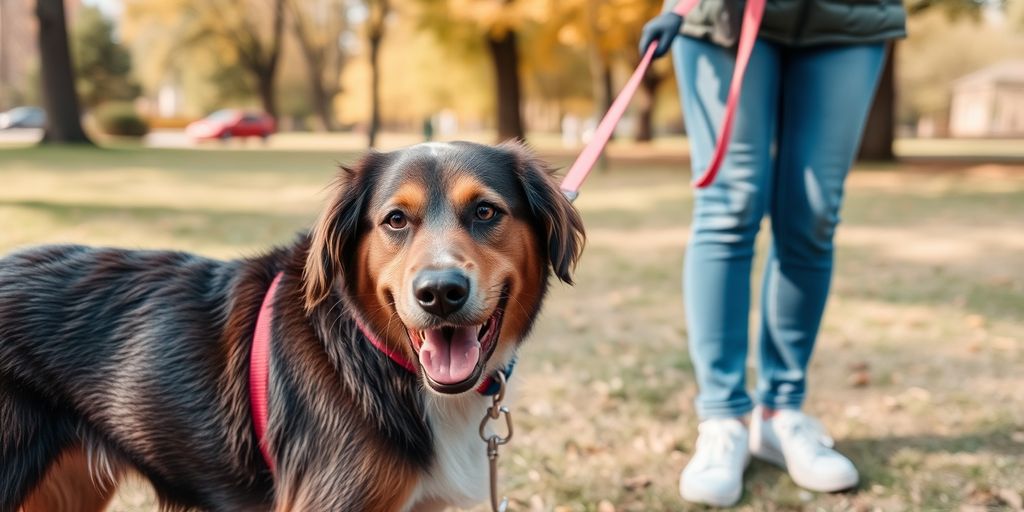Leash training is an essential skill for every dog owner. It not only ensures safety during walks but also strengthens the bond between you and your furry friend. This article provides practical tips and techniques to help new dog owners master leash training, making walks enjoyable for both you and your pet.
Key Takeaways
- Start leash training early to establish good habits.
- Choose a comfortable and suitable leash and collar.
- Use positive reinforcement to encourage desired behaviors.
- Practice in quiet areas before introducing distractions.
- Be patient and consistent, and take breaks when needed.
Building a Strong Foundation for Leash Training
Start Early for Success
Starting leash training early is key to success. The sooner you begin, the better your dog will adapt to walking on a leash. Puppies are like sponges, soaking up new experiences, so introducing them to the leash at a young age helps them feel comfortable and confident.
Choosing the Right Gear
Selecting the right gear is crucial for effective leash training. Here’s what you need:
- Sturdy Leash: A strong leash is essential for control.
- Harness vs. Collar: A harness is often better for beginners as it distributes pressure evenly and is safer for your dog’s neck.
- Comfortable Fit: Ensure the harness or collar fits well to avoid discomfort.
Understanding Your Dog's Behavior
Understanding your dog’s behavior is vital. Dogs communicate through body language, and recognizing signs of stress or excitement can help you adjust your training approach. For example:
- Tail Position: A wagging tail usually means happiness, while a tucked tail can indicate fear.
- Ears: Ears up can show curiosity, while ears back may signal anxiety.
Remember, patience is key! Training takes time, and every dog learns at their own pace.
Positive Reinforcement Techniques
Using Treats Effectively
When it comes to leash training, using treats is a game changer! Start by rewarding your dog with treats when they walk calmly beside you. This helps them associate good behavior with something they love. Just remember to gradually reduce the treats as they learn, so they don’t only perform for rewards.
Praise and Encouragement
Don’t underestimate the power of your voice! Use lots of praise and encouragement when your dog does well on the leash. A simple "good boy" or "great job" can boost their confidence and make them want to repeat the behavior. Celebrate those little victories!
Creating Positive Associations
Make walks a fun experience for your dog. If they pull on the leash, stop walking. This teaches them that pulling doesn’t get them where they want to go. Instead, reward them when they walk nicely. This way, they learn that calm behavior leads to more enjoyable walks.
Remember, leash training takes time and patience. Celebrate every small win to keep the training fun and engaging for both you and your dog!
Mastering the Basics of Leash Walking
Walking your dog on a leash is a skill that takes practice, but with the right approach, it can be a fun experience for both of you. Start by practicing in controlled environments where there are fewer distractions. This helps your dog focus on you and the leash training process.
Practicing in Controlled Environments
- Begin indoors or in a quiet backyard.
- Use treats to encourage your dog to stay close to you.
- Gradually introduce the leash while keeping it loose to avoid pulling.
Gradually Increasing Distractions
Once your dog is comfortable walking in a quiet space, it’s time to add some excitement! Take short walks in low-traffic areas. As your dog gets better, slowly increase the level of distractions. This could mean moving to busier parks or streets. Remember, patience is key!
Establishing a Routine
Creating a consistent walking routine helps your dog know what to expect. Try to walk at the same times each day. This not only builds good habits but also strengthens your bond.
Remember, leash training is a journey, not a race. Celebrate small victories along the way!
By following these steps, you’ll be well on your way to mastering leash walking with your furry friend. Happy walking!
Common Challenges and Solutions
As you embark on the journey of leash training, you might face some common challenges that many dog owners encounter. Understanding these issues can help you tackle them effectively. Here are a few typical problems and their solutions:
Dealing with Pulling
Pulling is one of the most frequent behaviors seen in dogs during walks. To manage this, try the following steps:
- Stop walking when your dog pulls.
- Wait for them to stop pulling before you start moving again.
- Reward them with treats and praise when they walk calmly.
Managing Distractions
Dogs can easily get distracted by other animals, people, or noises. To help your dog focus:
- Use treats or toys to redirect their attention.
- Practice in quieter areas before moving to busier environments.
- Gradually increase distractions as your dog becomes more comfortable.
Handling Leash Biting
If your dog tends to bite the leash, try these tips:
- Distract them with a toy or treat when they start biting.
- Use a different type of leash that is less appealing to chew on.
- Teach them a command like "leave it" to discourage the behavior.
Remember, patience and consistency are key! Every dog learns at their own pace, so celebrate small victories along the way!
Making Walks Enjoyable for Both of You
Incorporating Playtime
To make walks more fun, try to include some playtime during your outings. You can bring along a favorite toy or ball to toss around during breaks. This not only keeps your dog engaged but also helps burn off some extra energy. A happy dog is a well-behaved dog!
Exploring New Environments
Change up your walking routes to keep things exciting. Exploring new parks or neighborhoods can provide fresh sights and smells for your dog. This variety can make walks feel like an adventure, enhancing your dog's curiosity and enjoyment.
Setting Realistic Expectations
Remember, every dog is different. Some may take longer to adjust to leash training than others. Be patient and celebrate small victories. Here’s a quick list of tips to keep in mind:
- Start with short walks and gradually increase the distance.
- Allow your dog to sniff and explore, as this is part of their natural behavior.
- Keep a positive attitude; your dog will pick up on your energy!
By incorporating these tips and tricks, you can help foster a positive walking experience for your pup and help develop skills (and memories) that last a lifetime.
Highlighting Key Points
- Incorporate playtime to keep walks fun.
- Explore new environments to stimulate your dog’s senses.
- Set realistic expectations to ensure a positive experience for both of you.
Safety First: Keeping Your Dog Secure
Choosing the Right Leash and Collar
When it comes to keeping your dog safe, choosing the right leash and collar is key. A sturdy collar should fit snugly but not too tight, allowing you to fit two fingers underneath. For leashes, opt for a length that gives your dog some freedom to explore while still keeping them close. Here’s a quick guide:
| Type of Leash | Length | Best For |
|---|---|---|
| Standard | 4-6 ft | Everyday walks |
| Retractable | 10-30 ft | Open spaces |
| Training | 15-30 ft | Training sessions |
Understanding Leash Laws
Different places have different leash laws, so it’s important to know the rules in your area. Some parks require dogs to be leashed at all times, while others may have designated off-leash areas. Always check local regulations to avoid fines and ensure your dog’s safety.
Emergency Preparedness
Being prepared for emergencies can make a big difference. Here are some tips to keep in mind:
- Have a first aid kit for your dog at home and in your car.
- Know the nearest vet and have their contact information handy.
- Microchip your dog and keep their ID tags updated.
Remember, a little preparation goes a long way in keeping your furry friend safe and secure!
Celebrating Progress and Building Confidence
Recognizing Milestones
Celebrating your dog's achievements is key to building their confidence. Every small victory counts! Whether it's mastering a new command or walking calmly on a leash, take a moment to acknowledge these milestones. You can create a simple checklist to track progress:
| Milestone | Date Achieved | Notes |
|---|---|---|
| First successful walk | ||
| Mastered "sit" command | ||
| Walked past another dog |
Adjusting Training Techniques
As your dog grows and learns, you might need to adjust your training methods. If something isn’t working, don’t hesitate to try a different approach. Here are some tips:
- Be patient: Every dog learns at their own pace.
- Mix it up: Use different treats or toys to keep training exciting.
- Stay positive: Always encourage your dog, even when they make mistakes.
Encouraging Independence
Encouraging your dog to be independent can boost their confidence. Allow them to explore new environments safely. Here are some ways to do this:
- Short solo walks: Let your dog walk a short distance ahead of you.
- Playdates: Arrange playdates with other dogs to help them socialize.
- Interactive toys: Use toys that challenge them mentally, promoting self-reliance.
Remember, building confidence takes time and patience. Celebrate every step forward, and enjoy the journey with your furry friend!
Wrapping It Up: Enjoying the Journey Together
In conclusion, leash training is a fun and rewarding experience for both you and your dog. Remember, it’s all about patience and positivity. Start early, use the right gear, and always reward good behavior. With time and practice, you’ll both enjoy peaceful walks together. So, grab that leash, head out the door, and make some great memories with your furry friend. Happy walking!
Frequently Asked Questions
What is the best age to start leash training my dog?
It's best to start leash training when your dog is a puppy, around 8 weeks old. However, older dogs can learn too!
What type of leash and collar should I use for training?
A sturdy leash and a comfortable harness are recommended. Harnesses are safer and prevent neck injuries.
"Unlock the Secrets to a Blissful, Healthier Puppy: Discover the Benefits of Holistic Housebreaking"
How often should I practice leash training?
Practice for short sessions, about 5 to 10 minutes, a few times a day to keep your dog engaged and learning.
What should I do if my dog pulls on the leash?
If your dog pulls, stop walking until the leash is loose. Reward them when they walk calmly beside you.
Can I train my dog to walk on a leash if they are already an adult?
Yes! Adult dogs can learn leash manners too, but it may take a bit more time and patience.
How can I make leash training fun for my dog?
Use treats, praise, and playtime during training to make it enjoyable and rewarding for your dog.


